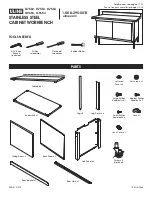
15
EATON XSTORAGE COMPACT INSTALLATION MANUAL
P-164000907 - March 2022 www.eaton.com
00
Title
3.7 Application controller
The control panel of the Eaton xStorage Compact system is a 7-inch color touch screen. It is a dual-purpose device,
providing both a local user interface for the control of the single xStorage Compact unit, and the means to manage
application-specific functions of the larger energy storage system.
As default, the control panel is placed on the front door of the system cabinet. As an option, the xStorage Compact
system is also available without the control panel.
In systems with multiple parallel Eaton xStorage Compact units, only a single application controller is needed to manage
all units.
The application controller offers several standard control algorithms, for example:
•
measurement reading from power meters,
•
control and monitoring of PV systems,
•
storage control, for example self-consumption or peak shaving on a user-defined programmable schedule,
•
customizable control functionality,
•
configuration of several grid connection parameters.
The application controller can monitor and control a generating plant of up to 5 parallel connected xStorage Compact
systems. For more information, refer to the
Eaton xStorage C&I Application controller user guide.
The system controller is based on the Eaton XC-303 modular PLC hardware. It is expanded centrally by XN322 slice
modules. The system controller enables the communication and monitoring of the devices connected to the internal
CAN bus.
The main functionality of the system controller unit is to:
•
acquire, consolidate and monitor available data from the battery packs and power conversion system (PCS)
•
control PCS operation
•
control battery system operation
•
manage various grid connection functions
•
enable connectivity with the application controller or client controller
4.1 Location and cooling requirements
The xStorage Compact ESS installation requires a TN-S, TN-C-S, TN-C or TT power distribution system.
The ESS installation must meet the following guidelines:
•
The system must be installed on a level floor. The floor must be suitable for heavyweight and wheeling.
•
The system must be installed in a temperature and humidity-controlled indoor area that is free of conductive
contaminants.
•
The cabinet can be installed in line-up-and-match or standalone configurations.
If you do not obey these guidelines the warranty may become void.
4. Site requirements and unpacking
















































